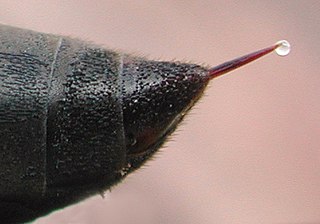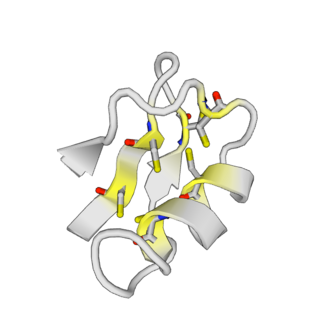Related Research Articles

A toxin is a naturally occurring organic poison produced by metabolic activities of living cells or organisms. They occur especially as proteins, often conjugated. The term was first used by organic chemist Ludwig Brieger (1849–1919) and is derived from the word "toxic".

Venom or zootoxin is a type of toxin produced by an animal that is actively delivered through a wound by means of a bite, sting, or similar action. The toxin is delivered through a specially evolved venom apparatus, such as fangs or a stinger, in a process called envenomation. Venom is often distinguished from poison, which is a toxin that is passively delivered by being ingested, inhaled, or absorbed through the skin, and toxungen, which is actively transferred to the external surface of another animal via a physical delivery mechanism.

Euglena is a genus of single cell flagellate eukaryotes. It is the best known and most widely studied member of the class Euglenoidea, a diverse group containing some 54 genera and at least 200 species. Species of Euglena are found in fresh water and salt water. They are often abundant in quiet inland waters where they may bloom in numbers sufficient to color the surface of ponds and ditches green (E. viridis) or red (E. sanguinea).

Tetrodotoxin (TTX) is a potent neurotoxin. Its name derives from Tetraodontiformes, an order that includes pufferfish, porcupinefish, ocean sunfish, and triggerfish; several of these species carry the toxin. Although tetrodotoxin was discovered in these fish, it is found in several other animals. It is also produced by certain infectious or symbiotic bacteria like Pseudoalteromonas, Pseudomonas, and Vibrio as well as other species found in symbiotic relationships with animals and plants.

Pfiesteria piscicida is a dinoflagellate species of the genus Pfiesteria that some researchers claim was responsible for many harmful algal blooms in the 1980s and 1990s on the coast of North Carolina and Maryland. North Carolinian media in the 1990s referred to the organism as the cell from hell. It is known to populate estuaries. Piscicida means "fish-killer".

Antivenom, also known as antivenin, venom antiserum, and antivenom immunoglobulin, is a specific treatment for envenomation. It is composed of antibodies and used to treat certain venomous bites and stings. Antivenoms are recommended only if there is significant toxicity or a high risk of toxicity. The specific antivenom needed depends on the species involved. It is given by injection.

Saxitoxin (STX) is a potent neurotoxin and the best-known paralytic shellfish toxin (PST). Ingestion of saxitoxin by humans, usually by consumption of shellfish contaminated by toxic algal blooms, is responsible for the illness known as paralytic shellfish poisoning (PSP).

Palytoxin, PTX or PLTX is an intense vasoconstrictor, and is considered to be one of the most poisonous non-protein substances known, second only to maitotoxin in terms of toxicity in mice.

Cardiotoxin III is a sixty amino-acid polypeptide toxin from the Taiwan Cobra Naja atra. CTX III is highly basic and hydrophobic protein. It is an example of a group of snake cardio/cytotoxins, which are made up of shorter snake venom three-finger toxins. Over 50 different cytotoxin polypeptides have been isolated and sequenced from venom samples. The difference in the CTX functionality may be due to the relatively small difference in the polypeptide's structure, allowing different CTXs to induce lysis in different cell types. The CTX III molecule contains multiple binding sites and is cytolytic for myocardial cells and human leukemic T cells.

Chlorotoxin is a 36-amino acid peptide found in the venom of the deathstalker scorpion which blocks small-conductance chloride channels. The fact that chlorotoxin binds preferentially to glioma cells has allowed the development of methods for the treatment and diagnosis of several types of cancer.

Venomous fish are species of fish which produce strong mixtures of toxins harmful to humans which they deliberately deliver by means of a bite, sting, or stab, resulting in an envenomation. As a contrast, poisonous fish also produce a strong toxin, but they do not bite, sting, or stab to deliver the toxin, instead being poisonous to eat because the human digestive system does not destroy the toxin they contain in their bodies. Venomous fish do not necessarily cause poisoning if they are eaten, as the digestive system often destroys the venom.
Solenopsin is a lipophilic alkaloid with the molecular formula C17H35N found in the venom of fire ants (Solenopsis). It is considered the primary toxin in the venom and may be the component responsible for the cardiorespiratory failure in people who experience excessive fire ant stings.

Toxic birds are birds that use toxins to defend themselves from predators. No species of bird is known to actively inject or produce venom, but the discovered toxic birds are known to be poisonous to touch and eat. These birds usually sequester poison from animals and plants they feed on, especially poisonous insects. Birds with known toxic traits include the pitohui and ifrita birds from Papua New Guinea, the European quail, the spur-winged goose, hoopoes, the bronzewing pigeon, and the red warbler, among others.

Lonomia obliqua, the giant silkworm moth, is a species of saturniid moth from South America. It is famous for its larval form, rather than the adult moth, primarily because of the caterpillar's defense mechanism, urticating bristles that inject a potentially deadly venom. The caterpillar has been responsible for many human deaths, especially in southern Brazil. Its venom has been the subject of numerous medical studies. The species was first described by Francis Walker in 1855. Guinness World Records classified the Lonomia obliqua as the most venomous caterpillar in the world.
Euglenophycin is an ichthyotoxic compound isolated from Euglena sanguinea, a protist of the genus Euglena. It exhibits anticancer and herbicidal activity in vitro.

Euglena sanguinea is a species of the genus Euglena. The red colour is due to the presence of astaxanthin and the cells can be populous enough to colour water red. The pigment is used to protect the chloroplasts from light that is too intense, but as the light levels change the cells can take on a green colour as the red pigment is moved to the centre of the cells. Euglena sanguinea is known to make the potent icthyotoxin euglenophycin. Icthyotoxin euglenophycin is a toxin that is very similar in structure to solensopsin, a alkaloid that is found in fire ant venom. This is the only known species of euglenids that is able to form toxic blooms that cause tangible losses to fish farms.
Hanatoxin is a toxin found in the venom of the Grammostola spatulata tarantula. The toxin is mostly known for inhibiting the activation of voltage-gated potassium channels, most specifically Kv4.2 and Kv2.1, by raising its activation threshold.
Dinotoxins are a group of toxins which are produced by flagellate, aquatic, unicellular protists called dinoflagellates. Dinotoxin was coined by Hardy and Wallace in 2012 as a general term for the variety of toxins produced by dinoflagellates. Dinoflagellates are an enormous group of marine life, with much diversity. With great diversity comes many different toxins, however, there are a few toxins that multiple species have in common.
TsIV is a toxin from the venom of the Brazilian scorpion Tityus serrulatus which slows the inactivation of sodium channels.

ImKTx88 is a selective inhibitor of the Kv1 ion channel family that can be isolated from the venom of the Isometrus maculatus. This peptide belongs to the α-KTx subfamily and is classified as a pore-blocking toxin.
References
- 1 2 Andersen N (2012). "Ichthyotoxic algae and their effects on fish" (PDF).
- ↑ Jawad LA (2018). Dangerous fishes of the Eastern and Southern Arabian Peninsula. Cham: Springer. ISBN 9783319579269.
- ↑ Ostrand KG, Thies ML, Hall DD, Carpenter M (1996). "Gar ichthyotoxin: Its effect on natural predators and the toxin's evolutionary function". The Southwestern Naturalist. 41 (4): 375–377. JSTOR 30055193.
- ↑ Zimba PV, Moeller PD, Beauchesne K, Lane HE, Triemer RE (January 2010). "Identification of euglenophycin--a toxin found in certain euglenoids". Toxicon. 55 (1): 100–4. doi:10.1016/j.toxicon.2009.07.004. PMID 19615398.
- ↑ Kulczycka A, Łukomska-Kowalczyk M, Zakryś B, Milanowski R (2018-06-01). "PCR identification of toxic euglenid species Euglena sanguinea". Journal of Applied Phycology. 30 (3): 1759–1763. doi:10.1007/s10811-017-1376-z. PMC 5982438 . PMID 29899599.
- ↑ Wahome PG, Beauchesne KR, Pedone AC, Cavanagh J, Melander C, Zimba P, Moeller PD (December 2014). "Augmenting anti-cancer natural products with a small molecule adjuvant". Marine Drugs. 13 (1): 65–75. doi: 10.3390/md13010065 . PMC 4306925 . PMID 25548974.
- 1 2 3 Cabang AB, De Mukhopadhyay K, Meyers S, Morris J, Zimba PV, Wargovich MJ (November 2017). "Therapeutic effects of the euglenoid ichthyotoxin, euglenophycin, in colon cancer". Oncotarget. 8 (61): 104347–104358. doi:10.18632/oncotarget.22238. PMC 5732811 . PMID 29262645.